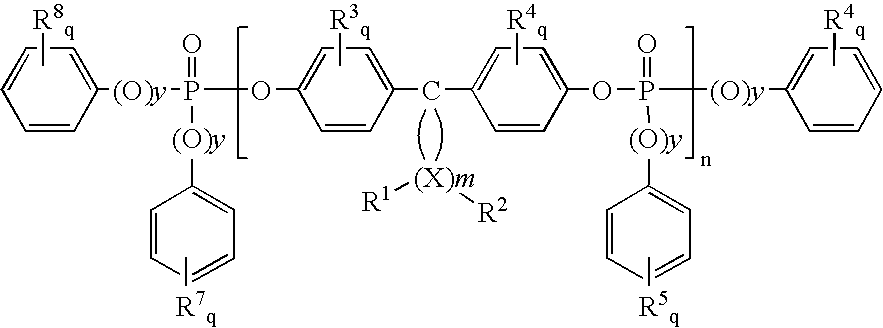Flame retardants which contain phosphorus, and flame-retardant thermoplastic molding compositions
a technology of flame retardant and thermoplastic molding composition, which is applied in the field of new oligophosphates, can solve the problems of unfavorable sanitary conditions, unsanitary conditions, and unsanitary conditions of injection molds, and achieves the effects of reducing the dimensional stability of these polymers reducing the juicing phenomenon, and easy increase of the dimensional stability under the effect of heat of the material
- Summary
- Abstract
- Description
- Claims
- Application Information
AI Technical Summary
Benefits of technology
Problems solved by technology
Method used
Image
Examples
example 1
Examples 1 to 4 Illustrate the Production of Flame Retardants According to the Invention.
[0131]A compound containing phosphorus according to the invention was obtained by the following reaction:
1.1 kg 3,3,5-trimethylcyclohexyl(TMC)-bisphenol and 1.0 l triethylamine were introduced at 5° C. in 2.0 l tetrahydrofuran. 2.0 kg phosphoric acid diphenyl ester chloride were steadily added drop-wise over a period of 2.5 hours at 5 to 9° C. The batch was subsequently stirred for 18 hours at room temperature. The salts were filtered off under suction and washed with tert.-butyl methyl ether (3×400 ml). The combined organic phases were washed with 1 N sodium hydroxide solution (3×500 ml) and water (500 ml), dried over magnesium sulphate and concentrated by evaporation. The residue was dissolved in dichloromethane (1000 ml) and was once again extracted with 1 N sodium hydroxide solution (3×1000 ml), and was then dried over magnesium sulphate and concentrated by evaporation. 2.0 kg of the white ...
example 2
[0133]A compound containing phosphorus according to the invention was obtained by the following reaction:
0.5 kg cyclohexyl-1,1-bis(4-phenol) and 0.40 kg triethylamine were introduced at 0° C. into 1.5 l tetrahydrofuran. 1.05 kg phosphoric acid diphenyl ester were steadily added drop-wise over a period of 3.5 hours at −5 to 12° C. The batch was subsequently stirred for 18 hours at room temperature. The salts were filtered off under suction and washed with tert.-butyl methyl ether (4×1000 ml). The combined organic phases were washed with 1 N sodium hydroxide solution (5×500 ml) and water (500 ml), dried over magnesium sulphate and concentrated by evaporation. 1.25 kg of compound (2) were thus obtained in a purity of 100%, corresponding to 91% theoretical. The following analysis results were obtained for this substance:
[0134]
HPLC-MS:purity: 100% of areaMS (ES+):733 (100) [MH+]P: elemental analysis:8.0% (theoretical value 8.4%)DIN acid number:0.76
example 3
[0135]A compound containing phosphorus according to the invention was obtained by the following reaction:
0.5 kg 3-methylcyclohexyl-1,1-bis(4-phenol) and 0.38 kg triethylamine were introduced at 0C into 1.5 l tetrahydrofuran. 1.00 kg phosphoric acid diphenyl ester was steadily added drop-wise over a period of 4.3 hours at −8 to 13° C. The batch was subsequently stirred for 18 hours at room temperature. The salts were filtered off under suction and washed with THF (1500 ml) and tert.-butyl methyl ether (2×1000 ml). The combined organic phases were washed with 1 N sodium hydroxide solution (5×500 ml) and water (500 ml), dried over magnesium sulphate and concentrated by evaporation. 1.27 kg of compound (3) were thus obtained in a purity of 100%, corresponding to 96% theoretical. The following analysis results were obtained for this substance:
[0136]
HPLC-MS:purity: 100% of areaMS (ES+):747 (100) [MH+]P: elemental analysis:8.0% (theoretical value 8.3%)DIN acid number:0.54
PUM
| Property | Measurement | Unit |
|---|---|---|
| glass transition temperature | aaaaa | aaaaa |
| glass transition temperature | aaaaa | aaaaa |
| glass transition temperature | aaaaa | aaaaa |
Abstract
Description
Claims
Application Information
 Login to View More
Login to View More - R&D
- Intellectual Property
- Life Sciences
- Materials
- Tech Scout
- Unparalleled Data Quality
- Higher Quality Content
- 60% Fewer Hallucinations
Browse by: Latest US Patents, China's latest patents, Technical Efficacy Thesaurus, Application Domain, Technology Topic, Popular Technical Reports.
© 2025 PatSnap. All rights reserved.Legal|Privacy policy|Modern Slavery Act Transparency Statement|Sitemap|About US| Contact US: help@patsnap.com



